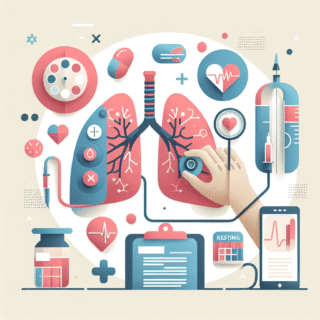
Your Health Magazine
4201 Northview Drive
Suite #102
Bowie, MD 20716
301-805-6805

More Family/Primary Care Articles
Treatment for Pulmonary Edema: Results, Ranges, and What They Mean

Pulmonary edema is a potentially life-threatening buildup of fluid in the lungs that impairs gas exchange and causes shortness of breath, low oxygen levels, and sometimes coughing up frothy sputum. Early recognition matters because prompt treatment pulmonary can reverse symptoms and prevent complications. This article explains common therapies, what test results and measurement ranges mean, and how clinicians decide which interventions to use for best outcomes.
Treatment for pulmonary edema: approaches and immediate goals
Initial management focuses on stabilizing breathing and circulation. For many patients, supplemental oxygen is the first step to correct hypoxemia. In cardiogenic pulmonary edema, loop diuretics such as furosemide reduce intravascular volume and pulmonary venous pressure. Vasodilators (e.g., nitroglycerin) and inotropes may be used when heart failure or low cardiac output is present. Noninvasive positive pressure ventilation (CPAP or BiPAP) often improves oxygenation and decreases work of breathing; mechanical ventilation is reserved for those who cannot protect the airway or remain hypoxemic despite other measures.
Common treatments and underlying causes
The choice of drug or device depends on the cause. Treatment of pulmonary edema due to heart failure will prioritize diuresis, afterload reduction, and optimization of cardiac function. If the edema is noncardiogenic — for example, from acute respiratory distress syndrome (ARDS), high-altitude exposure, or severe infection — management centers on lung-protective ventilation, treating the underlying trigger, and careful fluid balance. Renal failure may require dialysis to remove excess fluid. Treating the root cause is as important as addressing the lung fluid itself.
Key test results and ranges — what clinicians look for
Several measurements guide diagnosis and therapy:
- Oxygen saturation (SpO2): Normal ≥95%. Mild hypoxemia: 90–94%. Moderate: 80–89%. Severe: <80% often requires urgent advanced support.
- Arterial blood gas (ABG): PaO2 and PaCO2 give a snapshot of oxygenation and ventilation. Low PaO2 with normal or low PaCO2 is common early; rising PaCO2 can indicate respiratory fatigue.
- Chest X-ray: Cardiogenic pulmonary edema often shows bilateral perihilar “bat wing” or interstitial/alveolar infiltrates and cardiomegaly. Noncardiogenic causes may show more diffuse, patchy airspace opacities.
- Brain natriuretic peptide (BNP) or NT-proBNP: BNP <100 pg/mL makes heart failure less likely; markedly elevated values support a cardiac cause but should be interpreted with clinical context.
- Pulmonary artery catheter measurements (in selected cases): Pulmonary capillary wedge pressure (PCWP) >18 mmHg suggests cardiogenic edema. Values below this favor noncardiogenic causes.
- PaO2/FiO2 ratio: Used to grade severity of hypoxemia. Ratio <300 indicates acute lung injury; <200 suggests ARDS and more severe impairment.
Interpreting results and expected responses to therapy
After initiating treatment for pulmonary edema, clinicians monitor trends rather than single numbers. Improvement in SpO2 and PaO2, reduction in respiratory rate, clearer chest imaging, and falling BNP (in cardiogenic cases) indicate effective therapy. Rapid diuresis should reduce crackles on auscultation and lessen orthopnea. Lack of response may prompt escalation: higher oxygen flows, noninvasive ventilation, invasive monitoring, or transfer to an intensive care unit.
For authoritative, patient-facing information about causes and standard treatments, the National Heart, Lung, and Blood Institute provides a detailed overview that clinicians and patients often reference: NHLBI: Pulmonary Edema.
Longer-term management and prevention
Once stabilized, long-term care addresses the underlying disease: optimizing heart failure medications (ACE inhibitors, beta-blockers, mineralocorticoid receptor antagonists), managing hypertension, controlling fluid and salt intake, and treating sleep apnea or coronary disease if present. Patient education about symptom recognition and early outpatient follow-up reduces readmission risk. Rehabilitation, smoking cessation, and vaccination (influenza, pneumococcal) help lower future respiratory complication risk.
For more articles about managing respiratory emergencies and other current health topics, see our collection of recent issues and updates in the latest editions.
Explore our latest editions for related health guides and updates
- Takeaways:
- Pulmonary edema can be cardiogenic or noncardiogenic; treatment targets oxygenation and the underlying cause.
- Key measurements include SpO2, ABGs, chest imaging, BNP, and — when used — PCWP; trends guide therapy adjustments.
- Immediate interventions include oxygen, diuretics, vasodilators or inotropes (as appropriate), and noninvasive ventilation.
- Follow-up care focuses on preventing recurrence by treating heart, renal, or pulmonary contributors.
FAQ: What should I do if I or someone else develops sudden shortness of breath?
Call emergency services if shortness of breath is severe, rapid in onset, or accompanied by chest pain, fainting, confusion, or blue lips. While waiting for help, sit upright, stay calm, and if prescribed, use a short-acting nitrate (for suspected heart-related causes) or oxygen if available and instructed by a clinician.
FAQ: How long does it take to get better after treatment begins?
Improvement can be rapid with appropriate therapy—oxygenation and symptoms may improve within hours. Radiographic changes on chest X-ray may take days to weeks to fully resolve. Recovery time depends on severity, cause, comorbid conditions, and response to treatment.
FAQ: Can pulmonary edema be prevented?
Many cases related to heart failure can be reduced by managing cardiovascular risk: control blood pressure, adhere to heart failure medications, limit salt and fluid if recommended, avoid excessive alcohol, and seek early care for infections or cardiac symptoms. For other causes, prevention focuses on risk-specific measures such as gradual ascent for high-altitude exposure and protective measures to avoid inhalational injury.
Other Articles You May Find of Interest...
- From Checkups to Emergencies: When to Visit a Family Clinic vs. a Walk-In Clinic
- Your Questions Answered: Benefits Castor Oil
- What’s Pulmonary Edema?
- Why Is My Nipple Dry?
- Treatment for Pulmonary Edema: Results, Ranges, and What They Mean
- Coconut Oil for Vagina: Symptoms, Causes, and Treatment
- How to Treat Pulmonary Edema














